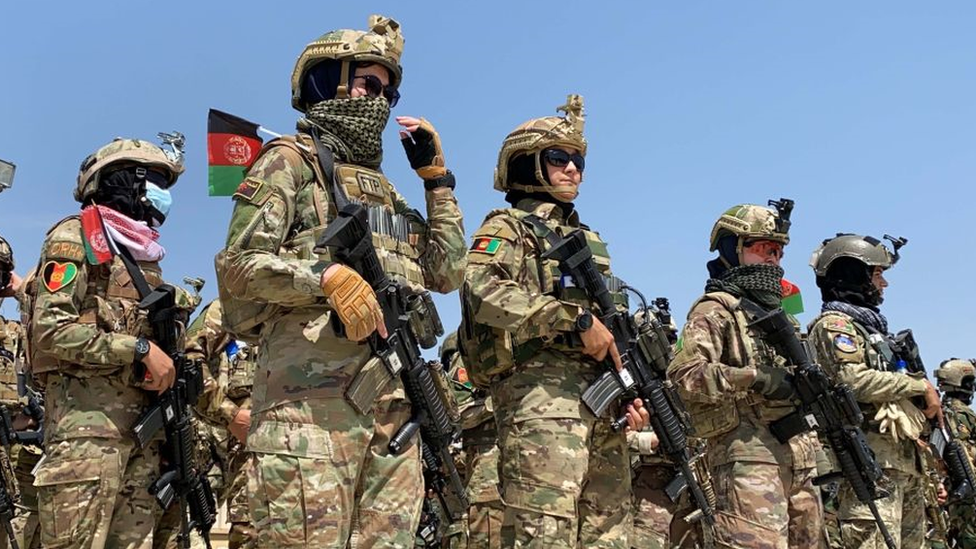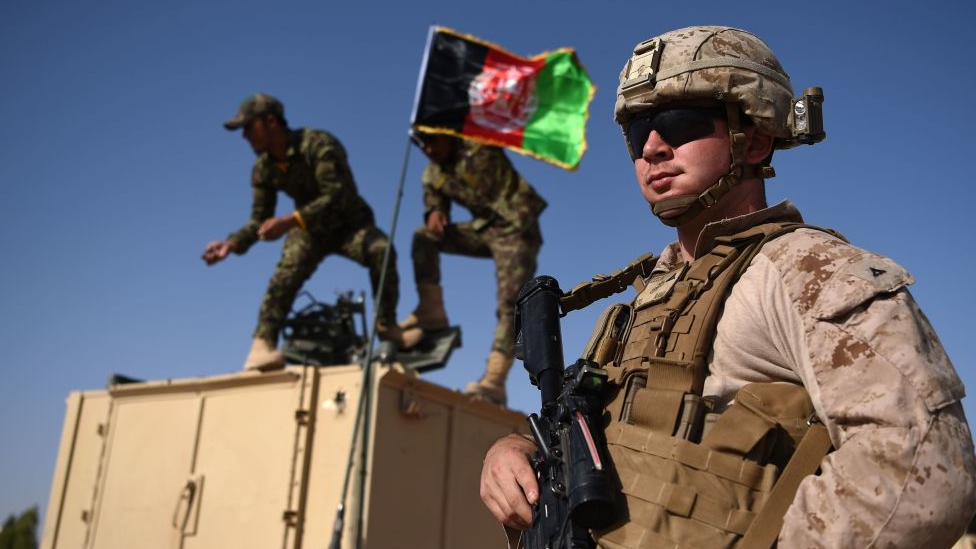Biden on Afghanistan fact-checked
- Published
'Chaos was inevitable', Joe Biden told ABC News
President Joe Biden has made a series of assertions about US policy in Afghanistan and the reasons behind his decision to withdraw forces from the country.
BBC News has fact-checked some of his claims, comparing them with his earlier statements on Afghanistan and the situation on the ground.'
'We trained and equipped an Afghan military force of some 300,000 strong'
This figure is contested and considered by many experts to be a substantial overestimate.
The US watchdog set up to monitor the situation in Afghanistan provides the basis for the president's figure, but it is misleading to use it out of context.
The US Special Inspector General for Afghanistan Reconstruction (Sigar) provides an overall figure for Afghan security forces in April 2021 of 300,699, external.
However, this figure combines both army/air force personnel (182,071) and the police force (118,628) - who are not deployed as part of the country's military.
The Sigar report notes that these figures also include "ghost" personnel. These would be non-existent or previously registered names, no longer active members of either the military or the police.
This, Sigar says, meant that "more than $300 million a year was spent paying salaries to non-existent personnel in the Afghan security forces."
A recent investigation by BBC Newsnight has uncovered evidence suggesting that the size of the army could be low as 50,000, external - much lower even than these SIGAR estimates.

Afghan military recruits graduating in Kabul, July 2021
'Are we going to continue to lose thousands of Americans to injury and death to try to unite that country?'
The last recorded American combat deaths in Afghanistan were in February 2020.
Since 2015, there have been 94 US deaths of military personnel in Afghanistan, external, according to the US Department of Defense.
Overall, since US forces invaded Afghanistan in October 2001, a total of 1,897 US military personnel have been killed in action in Afghanistan, external and another 415 have died from non-hostile causes, according to the US official monitoring body, Sigar.
More than 20,000 US soldiers have been wounded.

'Our mission in Afghanistan was never supposed to have been nation building'
In his television address on Monday evening, President Biden stressed the purpose behind the US intervention in Afghanistan had "always been preventing a terrorist attack on American homeland" and "never supposed to be creating a unified centralised democracy".
This clearly contradicts his previous positions on the US objective in Afghanistan.
At the outset of the conflict in 2001 when Mr Biden was a US senator, he outlined the long-term purpose of the American military intervention, saying: "Our hope is that we will see a relatively stable government in Afghanistan, one that… provides the foundation for future reconstruction of that country."
And again, in 2003 - in another quote, tracked down by the Politico website, external - he said the "alternative to nation building is chaos, a chaos that churns out bloodthirsty warlords, drug traffickers and terrorists".

US forces on a training exercise with Afghan soldiers
'Afghanistan's political leaders gave up and fled the country'
President Ashraf Ghani left the country with his aides, ahead of the Taliban advance into Kabul, despite having vowed several times to remain.
But other political leaders have remained and made public statements about doing so.
Former President Hamid Karzai, who served from 2001 to 2014, appeared in a video with his daughters, in which he said he was in Kabul and urged government forces and the Taliban to protect civilians.
Mr Karzai said all political leaders in the country would work to solve the issues peacefully and requested people to be patient.
The first Vice-President of Afghanistan, Amrullah Saleh, is also currently in the country, along with other leaders such as Ahmad Massoud, son of anti-Soviet military leader and politician Ahmad Shah Massoud.
And BBC News's Yalda Hakim has revealed the political leaders currently present in Afghanistan are forming an anti-Taliban coalition.
Allow X content?
This article contains content provided by X. We ask for your permission before anything is loaded, as they may be using cookies and other technologies. You may want to read X’s cookie policy, external and privacy policy, external before accepting. To view this content choose ‘accept and continue’.
'The Afghan military collapsed, sometimes without trying to fight'
It's true that the collapse of Afghan forces in the final few weeks of the conflict was dramatic.
However, this has to be seen in the context of the rapid, largely uncoordinated departure of international forces from the country.
When President Biden announced the withdrawal of US troops in April, eight thousand allied forces and eighteen thousand contractors who provided logistical support to the Afghan forces, external also left.
Afghan forces had relied heavily on these contractors and trainers over the past 20 years.
It's also worth noting that the Afghan army may have been well funded and equipped on paper, but the reality was different, often blamed on corruption and low morale.
Almost 70,000 Afghan police and military personnel have been killed fighting the Taliban in the last 20 years.
